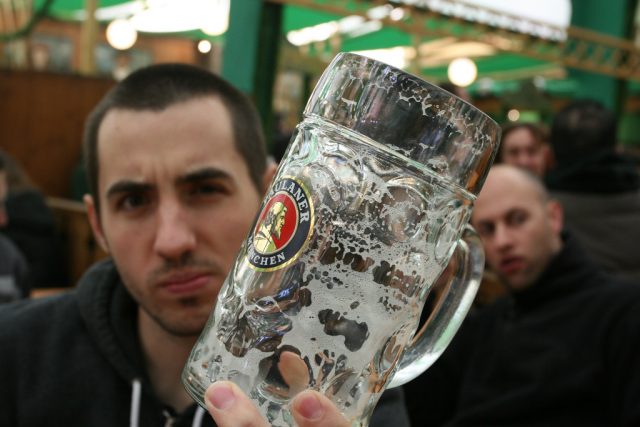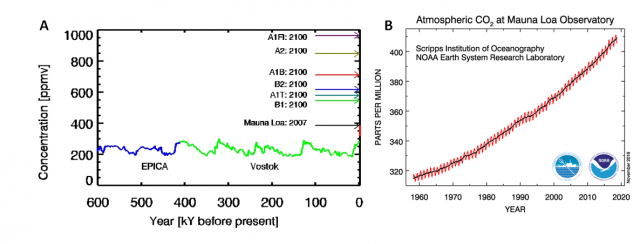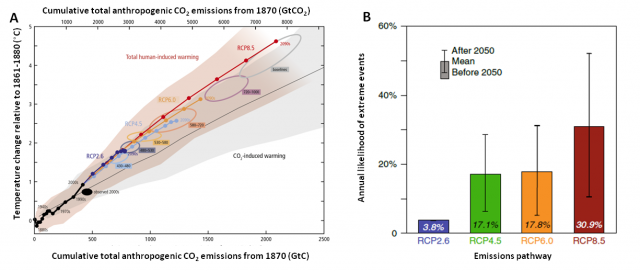Beer supply in danger

The history of Earth climate is characterized by a succession of glacial and interglacial periods. However, although climate change is inherent to Earth, the observed trend of temperature increase over the past century cannot be explained by climate models which include solar irradiance and are only explicable by the rise in greenhouse gases.
Mauna Loa Observatory in Hawai, a facility of the United States National Oceanic and Atmospheric Administration (NOAA), constitutes the longest record of direct CO2 measurements in the atmosphere starting in 1958. The first record corresponded to a concentration of 315 ppm of CO2 (Figure 1). Since then, CO2 atmospheric concentration has been constantly raising, reaching from 2015 concentrations higher than 400 ppm of CO2 (Figure 1). The origin of this rise can only be attributed to human activity, mostly due to the burning of fossil fuels. Indeed, when observing ancient CO2 records, coming from ice cores obtained by deep drilling in the context of the European Project for ICE Coring in Antarctica (EPICA) and also in the Vostok lake, in a project led by Russia, it is clear that this rise in the last century may only come from anthropogenic activities (Figure 1).

The increase in CO2 and greenhouse gases emission has a multi-faceted impact on climate change provoking the rising of temperatures but also changes in precipitation patterns, and increasing frequency of extreme weather events including heat waves, severe drought and floods.
Predicting plants responses to global climate change is one of the most important challenges that science and society face in this century. Indeed, the speed of climate change is so fast that new genetic adaptative mutations become powerless making the adaption of crops reliant to the already existent genetic diversity. The increase in CO2 availability is in principle beneficial for plant growth because of increasing plant photosynthesis and also plants water use efficiency, a topic recently treated in a post by Teresa Gimeno. Unfortunately, the overall effects of climate change on crops yield appear to be rather negative. Indeed, existing estimates suggest that climate trends since 1980 have already provoked a reduction of 5 % of maize and wheat yields 1.
Xie and collaborators, as an example on how climate change can affect crops yield and thus food availability, took as model an essential food for the world satisfaction and happiness: beer 2. The authors evaluated the vulnerability of global beer supply in the context of future climate change mostly focusing on the impact of extreme events (drought and heat waves) that may occur during the present century (Xie et al., 2018).
Beer is the most consumed alcoholic beverage in the world. Although it can be obtained from wheat, maize or even rice, most beer is obtained out of barley (Hordeum vulgare). To make beer, barley grains are malted, which means that grains start to germinate by degrading starch reserves in the seed into more simple sugar such as glucose, maltose or maltotrioses that give the name to malt. Afterwards, beer is obtained by the fermentation in water of the malted barley by yeast. Beer is commonly flavoured with hops, the flowers of the vine, climbing plant, Humulus lupulus.
Thus, Xie et al. first modelled how extreme climate events may impact the yield of beers primary ingredient, barley. To do so, they analyzed 34 world regions characterized by significant barley or beer production. Then, the authors examined how altering barley yield may affect beer supply and price in each region (Xie et al., 2018)

The authors analyzed four different future scenarios corresponding to four different Representative Concentration Pathways (RCP): RCP2.6, RCP4.5, RCP6.0 and RCP8.5. RCPs are trajectories defined by the Intergovernmental Panel on Climate Change (IPCC) according to predictions regarding the evolution of anthropogenic greenhouse gases emission. Figure 2 shows the CO2 emission together with their corresponding temperatures for these RCPs. Besides, Figure 2 also shows the likelihood of extreme events appearance corresponding to these four RCPs.
Overall, the authors concluded that the increasing appearance of extreme events because of climate change will provoke barley yield losses ranging from 3 to 17%. This yield loss will carry out a proportional decrease in barley availability for making beer and will result in a decrease in beer consumption and an increase in beer price (Xie et al. 2018). For instance, the estimations reveal that in Ireland, one of the countries with the highest beer consumption per capita with a monthly beer consumption of almost 25 bottles of 500 mL per capita (data from 2011), the price of the beer could increase to 193 % (Xie et al., 2018).

Obviously, the most worrisome impact of climate change for humanity is not beer consumption and availability but this is just an excellent example of how climate change may threaten agriculture and the availability of food products together with their economic accessibility.
References
- Lobell DB, Schlenker W and Costa-Roberts J (2011) Climate Trends and Global Crop Production Since 1980. Science 333, 616-620. ↩
- Xie W, Xiong W, Pan J, Ali T, Cui Q, Guan D, Meng J, Mueller ND, Lin E and Davis SJ (2018) Decreases in global beer supply due to extreme drought and heat. Nature Plants 4, 964–973. doi: 10.1038/s41477-018-0263-1 ↩